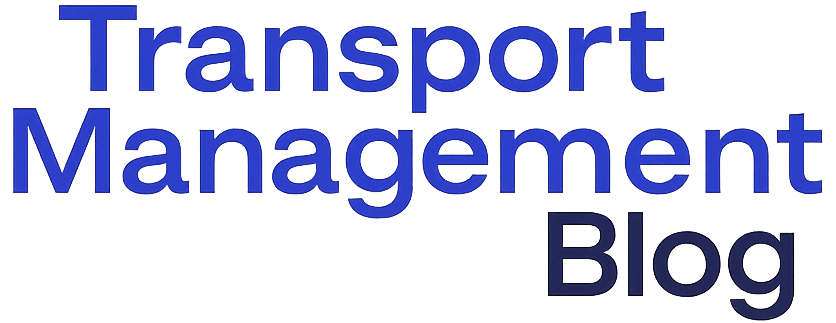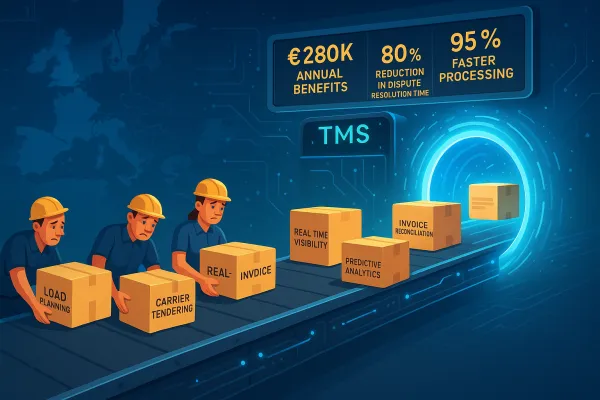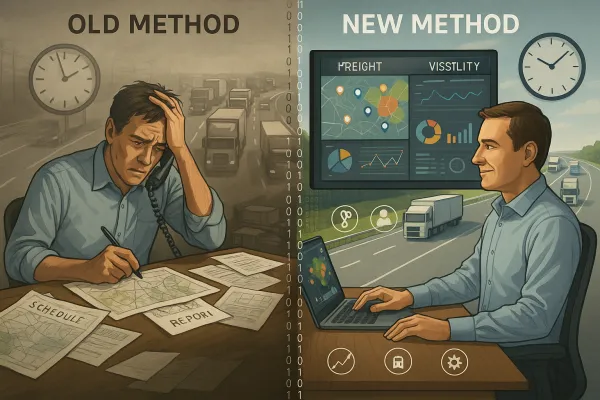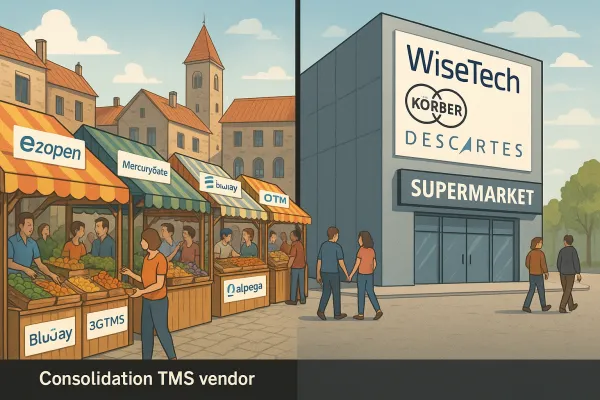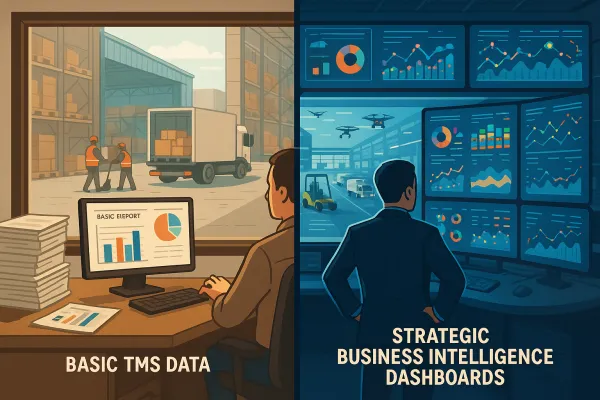The European Shipper's Guide to Bulletproof TMS Implementation: Avoiding the 40% Failure Rate That's Costing Companies Millions
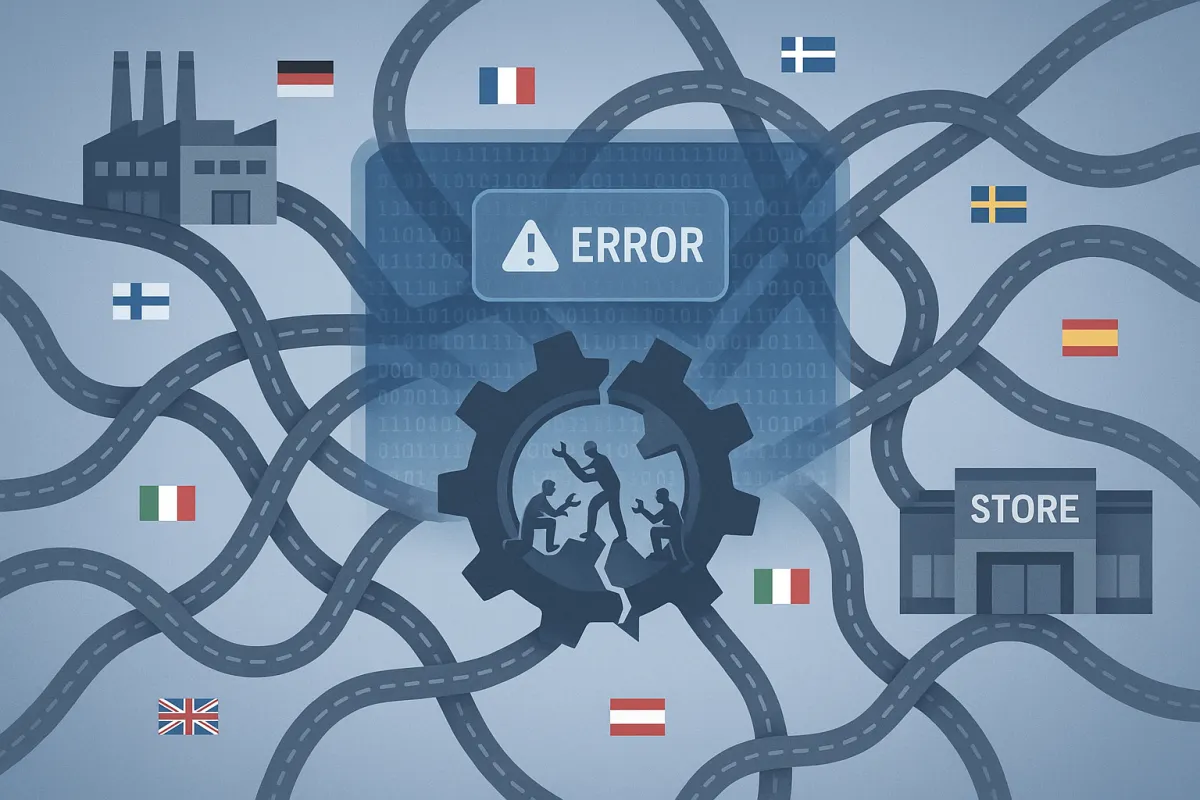
A mid-sized German automotive parts manufacturer thought their TMS implementation was going smoothly. Six months in, €800,000 spent, and they realized their new system couldn't handle their complex carrier network across 12 countries. According to the Standish Group's Annual CHAOS 2020 report, 66% of technology projects (based on the analysis of 50,000 projects globally) end in partial or total failure. Transportation management systems aren't immune to this trend. In fact, European shippers face even steeper odds due to cross-border complexities that don't exist in single-market implementations.
The numbers tell a sobering story. While larger projects are more prone to encountering challenges or failing altogether, research from McKinsey in 2020 found that 17% of large IT projects go so badly, they threaten the very existence of the company. For European companies managing transportation across multiple countries, currencies, and regulatory frameworks, the stakes are higher and the margin for error smaller.
The European Factor: Why Cross-Border Complexity Amplifies TMS Risks
Implementing a TMS in Germany is different from implementing one in Germany, France, Poland, and the Netherlands simultaneously. European shippers don't just need software that works—they need systems that handle 27 different VAT rates, multiple languages, varying carrier integration protocols, and soon, eFTI regulation compliance. The eFTI Regulation is set to transform freight transport within the EU by boosting efforts to replace paper-based documentation with electronic data in all transport modes. This digital shift will apply to road, rail, inland waterway, and air transport. It will reduce administrative burdens for operators and authorities, enhance data security, and ensure compliance with EU and national freight regulations.
The eFTI deadline isn't optional. As of 9 July 2027: The eFTI Regulation will apply in full. Member State authorities must accept information shared electronically by operators via certified eFTI platforms. Your TMS needs to be ready, or you'll face compliance gaps that could shut down cross-border operations.
The European Commission estimates eFTI could save the EU transport and logistics sector up to €1 billion per year. But only if your systems can actually support the digital transformation. Most legacy TMS solutions and rushed implementations won't be ready.
European shippers also deal with carrier networks that span everything from large multinational logistics companies to regional specialists who still fax rate sheets. Your TMS needs to handle API integrations with DHL and manual data entry for that crucial last-mile provider in rural Italy. This complexity doesn't exist in single-country implementations.
The Five Fatal Mistakes That Doom TMS Projects Before They Start
Mistake #1: Underestimating European Carrier Integration Complexity
A Dutch food distributor selected Oracle Transportation Management based on its North American success stories. They discovered too late that their system couldn't handle the different EDI standards used by German carriers versus French ones. For most businesses, implementing a TMS can take anywhere between 1-2 months (for small or mid-sized shippers) and 3-6 months (for a large enterprise). TMS implementation usually takes 1-2 months for smaller shippers and 3-6 months for a larger, more complex network. Add European complexity, and those timelines often double.
The problem compounds when you realize that Transporeon's integration requirements differ from nShift's, which differ from what smaller regional TMS providers like Cargoson offer. Each system handles multi-country operations differently. Some excel at European cross-border scenarios, others are better suited for single-market operations.
Mistake #2: Poor Data Migration and System Integration Planning
Your existing ERP knows about your suppliers in Munich and Milan. Your warehouse management system tracks inventory across locations. Your legacy TMS has years of carrier performance data. Getting all this data to play nicely together across different European subsidiaries, currencies, and languages isn't straightforward.
User requirements remain unclear. While few people like writing them or ever outlining them in broad strokes, you need precision about expectations and deliverables, whether waterfall or agile. European TMS implementations often fail because companies don't map out how their data flows between countries, subsidiaries, and systems.
Mistake #3: Inadequate Change Management and User Training
Your warehouse team in Barcelona works differently from your logistics coordinators in Stockholm. They speak different languages, use different processes, and have different relationships with local carriers. Rolling out a new TMS across these diverse operations requires more than a standard training program.
Companies often underestimate the cultural change management required for European implementations. When your Polish subsidiary has been managing transportation one way for 15 years, switching to a centralized TMS managed from headquarters in Frankfurt creates resistance that goes beyond typical software adoption challenges.
Mistake #4: Misaligned Vendor Selection
SAP Transportation Management might be perfect for your German operations but struggle with the specific requirements of your Italian subsidiary. MercuryGate excels in North America but might not have the European carrier network coverage you need. Alpega has strong European market presence but might be overkill for a mid-sized operation.
Newer European-focused solutions like Cargoson are built specifically for cross-border European operations, while established players like Descartes have been adapting their global solutions for European complexities.
The vendor selection mistake happens when companies don't properly weight European-specific requirements during evaluation. A TMS that scores highest on general functionality might rank lowest on European compliance and integration capabilities.
Mistake #5: Unrealistic Timeline and Resource Allocation
Planning is over-optimistic. Zero-based budgeting is ignored. Companies budget for a straightforward software implementation, not a complex multi-country business transformation. They allocate resources for basic training, not for the extensive change management required across diverse European operations.
The timeline issue gets worse when you factor in holidays, language barriers, and the need to coordinate testing across multiple time zones and subsidiaries. Your German team might be ready to go live, but your Spanish subsidiary needs three more weeks because their key transportation manager was on vacation when training occurred.
Building Your Implementation Success Framework: The 7-Phase Approach
Phase 1: Pre-Implementation Audit and Requirements Mapping
Before you touch any software, map your current transportation processes across all European operations. Document how your German subsidiary handles carrier selection differently from your French one. Identify where your processes align and where they diverge. This isn't just about software requirements—it's about understanding how transportation management actually works in your organization.
Include eFTI compliance requirements in your audit. The presentation stressed the importance of using harmonised e-CMR data to simplify enforcement, customs, and VAT processes, while supporting real-time updates from ERP and TMS systems. Your new TMS needs to handle these digital documentation requirements from day one.
Phase 2: European-Focused Vendor Selection
Weight European-specific capabilities heavily in your scoring. Can the TMS handle multiple currencies in the same shipment? Does it support the carrier integration standards used by major European logistics providers? Can it generate the documentation required for cross-border European transport?
Evaluate vendors like SAP TM for enterprise-grade European operations, Oracle TM for large-scale implementations, or Cargoson for mid-market European-focused operations. Each has different strengths in the European context.
Phase 3: Integration Architecture Planning
Design your integration architecture to handle European complexity from the start. Your TMS needs to pull data from ERPs in Germany and Italy, integrate with carriers across 15 countries, and feed information back to various warehouse management systems.
Plan for API failures, data format differences, and the inevitable carrier who still only accepts EDI formats from 1995. Build redundancy and error handling into your integration architecture.
Phase 4: Data Preparation and Migration Strategy
Clean your data before migration, not after. Your German carrier database might list "Deutschland" while your French system uses "Allemagne" for the same country. Standardize this before you migrate, or spend months cleaning up data inconsistencies in production.
Plan for different data privacy requirements across European countries. GDPR compliance isn't just about having a privacy policy—it affects how you can store and process transportation data across borders.
Phase 5: Phased Rollout Approach
Don't go live across all European operations simultaneously. Start with your most standardized country operation, learn from the implementation, then roll out to more complex markets.
A successful pattern: Germany first (good infrastructure, processes), then Netherlands or Belgium (similar business practices), then France and Italy (more complex), finally Eastern European operations (most different from headquarters norms).
Phase 6: Multi-Country Training and Change Management
Training isn't just about showing people how to use the new system. It's about changing how they think about transportation management. Your Italian subsidiary might be used to managing everything locally. Your new TMS might centralize certain decisions at the regional level.
Provide training materials in local languages, account for different business cultures, and assign local champions who understand both the new system and local transportation practices.
Phase 7: Continuous Optimization and Compliance Monitoring
European regulations change. Carrier networks evolve. Your TMS implementation isn't finished when you go live—it needs ongoing optimization to handle the dynamic European transportation environment.
Set up monitoring for eFTI compliance, carrier performance across countries, and cost optimization opportunities that might exist in one country but not others.
The European Shipper's Pre-Flight Checklist: 25 Must-Have Items
Before you sign your TMS contract, verify these European-specific requirements:
Technical Requirements:
- Multi-currency support within single shipments
- EU VAT rate handling across all member states
- eFTI-ready data formats and compliance reporting
- Integration with major European carrier networks (Transporeon, 4PL Central, others)
- Support for European EDI standards (EDIFACT, not just ANSI X12)
- GDPR-compliant data processing across borders
Operational Requirements:
- Multi-language user interface and documentation
- European carrier rate comparison capabilities
- Cross-border customs documentation generation
- Intrastat reporting for EU trade statistics
- Dangerous goods handling per European ADR requirements
- European driver working time directive compliance
Vendor Evaluation Criteria:
- European implementation team availability
- Local support in your time zones
- References from similar European multi-country implementations
- Partnership agreements with European carriers and service providers
- Roadmap alignment with European regulatory changes
Solutions like Cargoson specifically target European cross-border complexity, while enterprise solutions like SAP TM and Oracle TM offer broader functionality but require more configuration for European requirements.
Crisis Management: What to Do When Implementation Goes Wrong
Warning signs appear early. Your German team loves the new system, but your Italian subsidiary can't get their carriers integrated. Training completion rates are high in Northern Europe but low in Southern Europe. Your go-live date approaches, but half your operations aren't ready.
When European TMS implementations go sideways, the problems compound quickly. A carrier integration issue in one country affects shipments to three others. A data migration error in your ERP affects transportation planning across your entire European network.
Recovery strategies for European implementations:
Partial Go-Live: Launch in ready countries first. Don't delay your entire European operation because one subsidiary isn't prepared.
Temporary Parallel Processing: Run old and new systems simultaneously in problematic markets until issues resolve. Yes, it's expensive, but it's cheaper than stopping all transportation operations.
Vendor Escalation: European TMS vendors understand cross-border complexity better than their global counterparts. Don't hesitate to escalate to their European implementation specialists.
Local Expert Support: Sometimes you need consultants who understand both the software and the specific European transportation environment. They cost money but can solve integration issues faster than remote support.
Success Stories: European Companies That Got It Right
A European automotive parts manufacturer with operations in six countries took 18 months to implement their TMS properly. They started with a comprehensive audit of their carrier networks, standardized their data formats before migration, and rolled out country by country over 12 months. The result? 25% reduction in transportation costs and full eFTI compliance readiness.
They succeeded because they treated the project as business transformation, not software implementation. They allocated budget for extensive change management, hired European transportation consultants who understood both the software and local market requirements, and gave their implementation team authority to make decisions across subsidiaries.
Another success: A Dutch food distributor implemented a modern European-focused TMS to replace three different legacy systems across their operations. By consolidating on a solution designed for European cross-border transportation, they eliminated data integration issues that had plagued their previous setup. Their implementation took eight months but delivered immediate ROI through better carrier rate optimization across their European network.
The implementation of a management process, however, is shown to reduce the failure rate to 20% or below. These companies succeeded because they followed disciplined implementation processes designed for European complexity, not generic software deployment methods.
The key factors in their success: realistic timeline expectations, extensive pre-implementation planning, European-experienced implementation teams, and treating the project as a business transformation requiring change management across multiple countries and cultures.
European TMS implementations don't have to join the 40% failure rate. Companies that understand the unique challenges, plan appropriately, select the right solutions for their European requirements, and execute with disciplined project management consistently deliver successful outcomes. The cost of getting it right is lower than the cost of getting it wrong—especially with eFTI compliance deadlines approaching.
